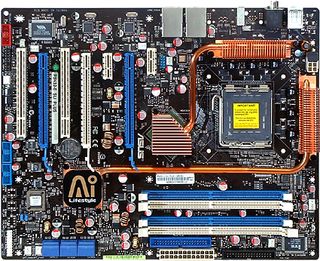Seven 650i SLI Motherboards Compared
Asus P5N32-E SLI Plus: Mod Rod
Asus takes the high road in its P5N32-E SLI Plus, a board designed to be a more economical alternative to the company's 680i SLI products. A radical departure from every other board in this comparison, even the chipset combination is modified for performance fanatics.
Features Overview
Asus' high-end 650i board isn't really a 650i SLI board at all: Rather, it's Asus' brew of Nvidia technologies both blue and green that together supply total of 46 PCI-Express lanes where the standard 650i contains only 18. The end result supports two PCI-Express x16 slots with the full sixteen pathways, a third x16 slot with x8 pathways, and six additional PCI-Express x1 slots and onboard devices.

The actual mix of chipset components should surprise all but the geekiest of enthusiasts: Rather than use the complete 650i SLI combination which contains the 680i LT Northbridge and old nF430 Southbridge carried forward from the 6100 chipset series, Asus used the "650i" Northbridge and the nForce 570 SLI single-component "chipset" for AMD as the Southbridge. This is possible because Nvidia uses the same HyperTransport link method between its Northbridge and Southbridge as AMD uses between its processor and a Northbridge. The combination startlingly resembles the complete 680i LT chipset, and Asus calls its creation "Nvidia Dual x16 SLI".
But extra PCI-Express lanes aren't the only thing Asus has in store for P5N32-E SLI Plus buyers: The board also features an eight-phase capacitor-free CPU voltage regulator such as typically only found on the most expensive boards, plus a few mixed-chipset added features such as Nvidia dual-gigabit networking and support for six Serial ATA plus two Ultra ATA drives, rather than the four plus four combination found in standard 650i SLI configurations.
Power cable connections are almost ideally located for traditional tower case designs, with the 8-pin ATX12V connector on the top edge and the 24-pin ATX connector along the front. Some builders may need to rout floppy and ATX power cables around each other, but the design is still superior to those that place the floppy connector near the board's bottom.
The single Ultra ATA connector is also located almost perfectly for reaching the middle and upper expansion bays of most cases. Once again builders may find themselves routing this data cable around the ATX power cable, but it's far better than pulling the cable up from the bottom as with many other boards.
Six Serial ATA connectors are all located near the bottom, facing forward to eliminate conflicts with long graphics cards. While this provides easy reach to typical internal drive bays, some awkward case designs place one edge of the lower cage so close to the board's front edge that using these ports may be impossible. Several motherboards have used this cable layout for a few product cycles, so well-designed cases shouldn't have such issues.
Asus made some strange decisions concerning what to eliminate from this otherwise upper-range board: Empty solder points indicate places were internal power, reset, and BIOS reset buttons would have gone, as well as vacant eSATA controller and connector locations. None of these features are expected in the midrange market, but can still be found on cheaper models.
Front panel audio and USB connections are eased by Asus' use of an audio riser card with an "FP" header in the top slot and a 2-port USB connection immediately above it. But that 2-port connection was normally reserved for a USB mini wireless card in other "AI Lifestyle" models, which begs the question why Asus used this moniker rather than its "Republic of Gamers" logo.
| Asus P5N32-E SLI Plus (Revision 1) | |
|---|---|
| Northbridge | NVIDIA nForce 650i SLI (C55 SPP) |
| Southbridge | nForce 570 SLI (MCP55P) |
| Voltage Regulator | Eight Phases |
| BIOS | 0501 (02/15/2007) |
| 266.7 MHz (FSB1066) | 267.3 MHz (+0.0%) |
| Connectors and Interfaces | |
| Onboard | 3x PCIe x16 (2x x16 plus 1x x8 pathways)1x PCIe x12x PCI3x USB 2.0 (2 ports per connector)1x IEEE-1394 FireWire1x Floppy1x Ultra ATA6x Serial ATA 3.0Gb/s1x Audio Slot1x S/P-DIF Out1x Fan 4 pins (CPU)7x Fan 3 pins (System) |
| IO panel | 2x PS2 (keyboard + mouse)2x RJ-45 Network4x USB 2.01x IEEE-1394 FireWire2x Digital Audio Out (S/P-DIF optical, coaxial) |
| Mass Storage Controllers | |
| MCP55P | 6x SATA 3.0Gb/s (RAID 0,1,5,10 capable)1x Ultra ATA-133 (2-drives) |
| Network | |
| Dual NVIDIA Gigabit Network | 2x Marvell 88E1116 PHY |
| Audio Riser Card | |
| HDA (Azalia) Controller Interface | ADI 1988B 7.1 Codec |
| FireWire | |
| VIA VT6308P | 2x IEEE-1394a (400 Mbit/s) |
A custom riser card that holds the ADI1988B audio codec also supports six analog ports, moving these noise-sensitive components away from motherboard circuitry for potentially cleaner output. This particular codec also supports DTS Connect, for real-time digital encoding of multi-channel sound to one of two available digital audio connectors on the board itself.

The rear panel loses legacy Parallel and Serial ports but keeps the PS/2 keyboard and mouse ports, adding four USB 2.0, two RJ-45 Network, and one IEEE-1394 FireWire port.
Current page: Asus P5N32-E SLI Plus: Mod Rod
Prev Page BIOS And Overclocking Next Page BIOS And OverclockingStay on the Cutting Edge
Join the experts who read Tom's Hardware for the inside track on enthusiast PC tech news — and have for over 25 years. We'll send breaking news and in-depth reviews of CPUs, GPUs, AI, maker hardware and more straight to your inbox.

